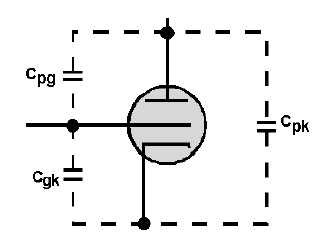1-43
As you can see, tube 2 is 10 times the amplifier that tube 1 is.
Q26.
The plate voltage of a tube will vary 126 volts when a 3-volt ac signal is applied to the control
grid. What is the gain of this tube?
Q27.
If the mu of a tube is 85 and the signal at the control grid is 4 volts ac, the plate voltage will
vary by what amount?
Q28.
Transconductance is a measure of the relationship between what two factors?
Q29.
A tube has a transconductance of 800 mhos and a load resistor of 50 kohms. When control grid
voltage varies by 6 volts, the plate voltage will vary by what amount?
INTERELECTRODE CAPACITANCE
As you know, capacitance exists when two pieces of metal are separated by a dielectric.
You should also remember from your studies that a vacuum has a dielectric constant of 1. As the
elements of the triode are made of metal and are separated by a dielectric, capacitance exists between
them. This capacitance is called interelectrode capacitance, and is schematically represented in figure
1-29.
Figure 1-29.—Schematic representation of interelectrode capacitance.
Notice that there are three interelectrode capacitances involved in a triode. The capacitance between
the plate and grid, designated Cpg, is the largest, because of the relatively large area of the plate, and
therefore has the greatest effect on triode operation. The grid-to-cathode capacitance is designated Ckg.
The total capacitance across the tube is designated Cpk.
As we said earlier, Cpg has the greatest effect on the tube operation. This is because this capacitance
will couple part of the ac signal from the plate back to the grid of the tube. The process of coupling the
output of a circuit back to the input is called FEEDBACK. This feedback affects the gain of the stage. It
may be desirable in some applications. In others, the effects must be neutralized. The effects of Cpk are
greater at higher frequencies where Xc is lower.


